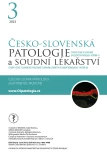Plicní tuková embolie po nepřímé masáži srdce
Authors:
Lucia Ihnát Rudinská 1; Patricie Delongová 2; Jana Vaculová 2; Peter Ihnát 3
Authors place of work:
Ústav soudního lékařství, Fakultní nemocnice Ostrava, Ostrava
1; Ústav klinické a molekulární patologie a lékařské genetiky, Fakultní nemocnice Ostrava, Ostrava
2; Chirurgická klinika, Fakultní nemocnice Ostrava, Ostrava
3
Published in the journal:
Soud Lék., 68, 2023, No. 3, p. 33-36
Category:
Původní práce
Summary
Pulmonary fat embolism (PFE) is usually observed in patients with long bone fractures, patients with extensive subcutaneous fat contusions or skin burns. Chest compressions during cardiopulmonary resuscitation (CPR) present powerful repetitive violence against victim’s chest. Skeletal chest fractures are the most frequent complication of CPR, and probably the most important cause of PFE autopsy finding in persons, which have been resuscitated before death. The aim of the present paper was to investigate the prevalence and seriousness of PFE in non-survivors after out-of-hospital cardiac arrest.
During autopsy, PFE can be diagnosed in 30 – 42 % of persons after unsuccessful CPR; skeletal chest fractures are associated with significantly higher prevalence of PFE. After successful CPR, fat embolism may contribute significantly to acute respiratory distress syndrome, or multiorgan failure. The issue of CPR associated injuries has two medical aspects – clinical and forensic. From clinical point of view, the presence of CPR associated injuries must be acknowledged when offering healthcare to patients after successful CPR. During autopsy, CPR associated injuries should be diagnosed and evaluated as these injuries may contribute to death or may be potentially lethal.
Keywords:
frozen section – cardiopulmonary resuscitation – fat embolism – rib fractures
Zdroje
- Voisard MX, Schweitzer W, Jackowski C. Pulmonary fat embolism--a prospective study within the forensic autopsy collective of the Republic of Iceland. J Forensic Sci 2013; 58 Suppl 1: S105-111.
- Eriksson EA, Pellegrini DC, Vanderkolk WE, Minshall CT, Fakhry SM, Cohle SD. Incidence of pulmonary fat embolism at autopsy: an undiagnosed epidemic. J Trauma 2011; 71(2): 312-315.
- Kumar V, Abbas AK, Fausto N, et al. Robbins & Cotran Pathologic Basis of Disease. 7. vydání. Philadelphia: Elsevier Saunders 2005. ISBN 978-0808923022.
- Truhlář A, Hejna P, Žabka L, Zátopková L, Černý V. Poranění hrudníku při mechanické srdeční masáži – pilotní studie. Urgentní medicína 2011; 1(2): 14–19.
- Travers AH, Rea TD, Bobrow BJ, et al. Part 4: CPR overview 2010 American heart association guidelines for cardiopulmonary resuscitation and emergency cardiovascular care. Circulation 2010; 122(6): S676-684.
- Truhlář A, Kasal E, Černý V. Přehled nejvýznamnĕjších zmĕn v Doporučených postupech pro neodkladnou resuscitaci. Anesteziologie a Intenzivni Medicina 2011; 22(2):115-123.
- Hashimoto Y, Moriya F, Furumiya J. Forensic aspects of complications resulting from cardiopulmonary resuscitation. Legal Medicine 2007; 9(2): 94-99.
- Ihnát Rudinská L, Hejna P, Ihnát P, Tomášková H, Smatanová M, Dvořáček I. Intra-thoracic injuries associated with cardiopulmonary resuscitation – frequent and serious. Resuscitation 2016; 103(6): 66-70.
- Cuculič D, Stemberga V, Coklo M, Sosa I, Stifter S, Bosnar A. Trauma related fat embolism syndrome in forensic practice. Collegium antropologicum 2010; 34(2): 723-726.
- Nádvorník F, Řehánek L, Vorel F. Výskyt tukových embolií u 400 přípradů traumatických smrtí. Acta chirurgiae orthopaedicae et traumatologiae Čechoslovaca 1963; 30(2): 190-196.
- Milroy CM, Parai JL. Fat Embolism, Fat Embolism Syndrome and the Autopsy. Acad Forensic Pathol 2019; 9(3-4): 136-154.
- Miller P, Prahlow JA. Autopsy diagnosis of fat embolism syndrome. Am J Forensic Med Pathol 2011; 32(3): 291-9.
- Miller AC, Rosati SF, Suffredini AF, Schrump DS. A systematic review and pooled analysis of CPR-associated cardiovascular and thoracic injuries. Resuscitation 2014; 85(6): 724-31
- Buschmann CT, Tsokos M. Frequent and rare complications of resuscitation attempts. Intensive Care Med 2009; 35(3): 397-404.
- Kim MJ, Park YS, Kim SW, et al. Chest injury following cardiopulmonary resuscitation: a prospective computed tomography evaluation. Resuscitation 2013; 84(3): 361-4.
- Šteiner I, Klempířová A. Nepřímá masáž srdce jako příčina tukové embolie plic. Cesk Patol 1990; 26(2): 109-11.
Štítky
Patologie Soudní lékařství ToxikologieČlánek vyšel v časopise
Soudní lékařství

2023 Číslo 3
Nejčtenější v tomto čísle
- Sebevražda nebo nehoda? Problematika anafylaxe s analýzou odborné literatury
- Plicní tuková embolie po nepřímé masáži srdce
- Samovraždy v regióne severného Slovenska: retrospektívna, monocentrická štúdia za – obdobie 10 rokov
- Konference Společnosti medicínského práva ČLS JEP
